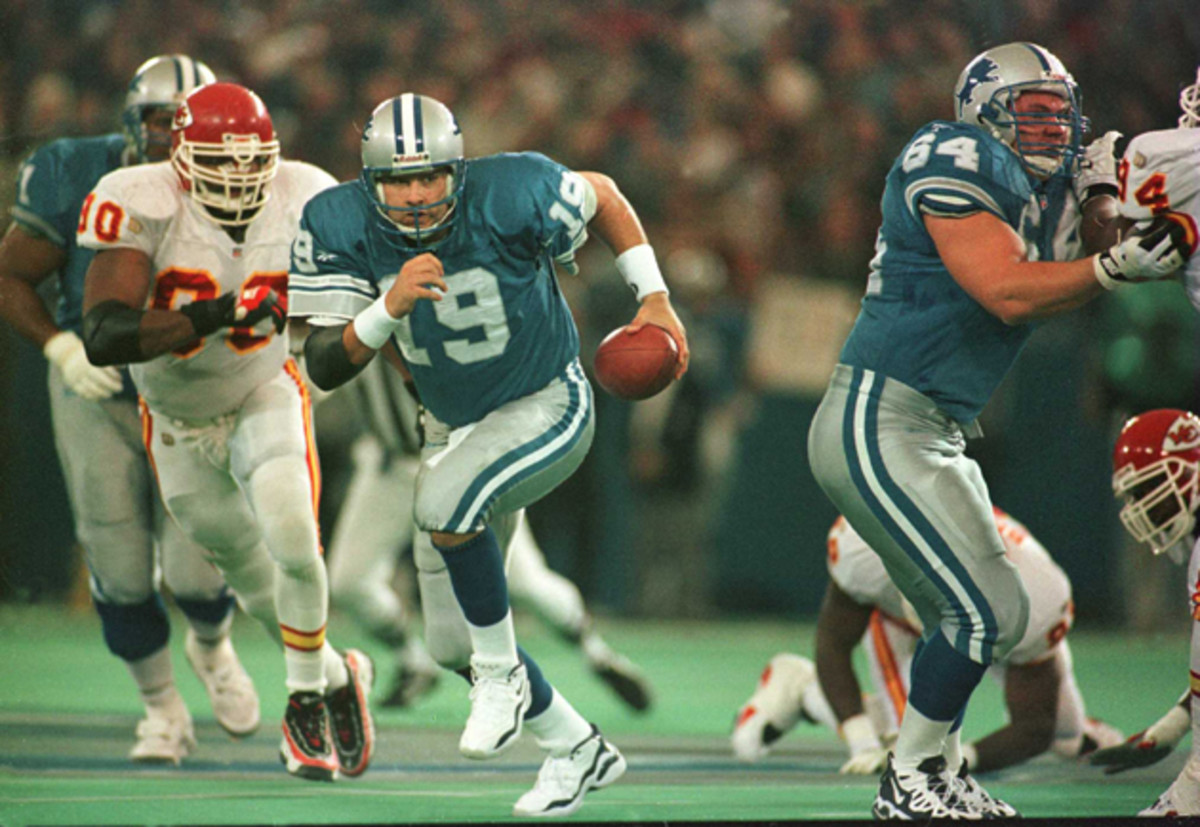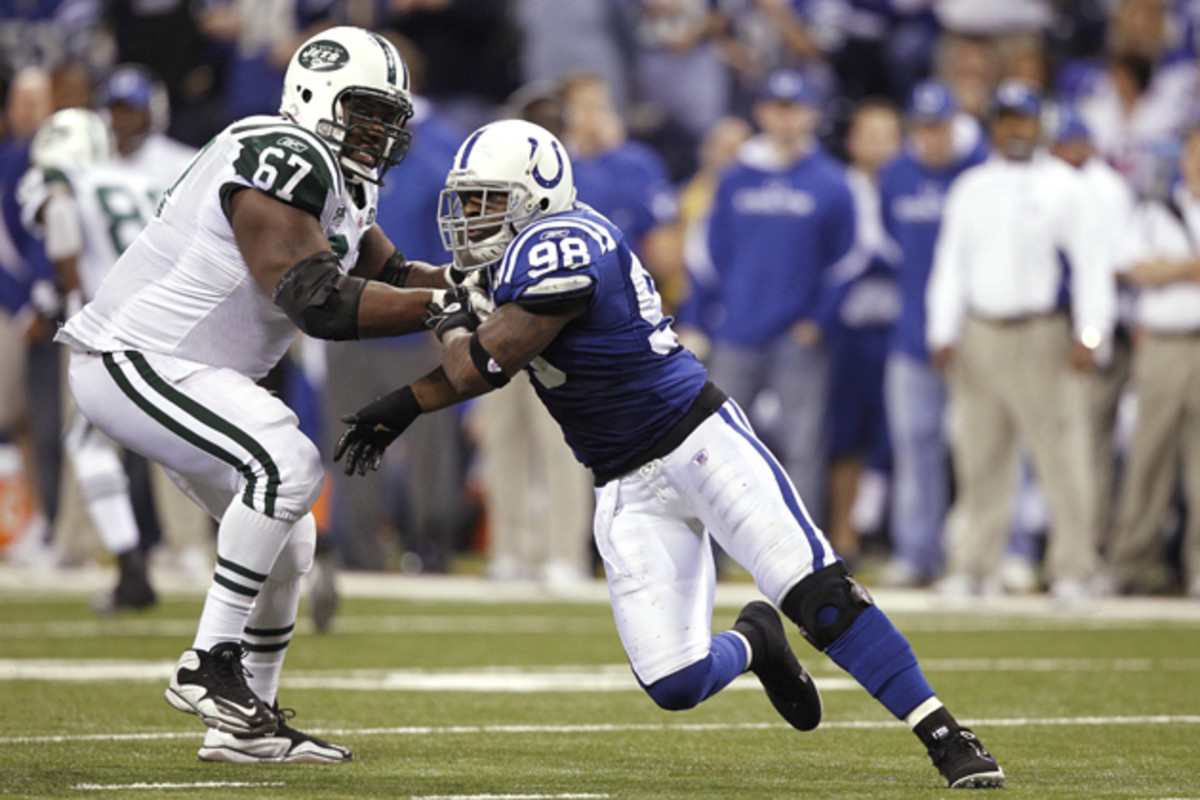Former NFL players Damien Woody, Scott Mitchell deal with weight gain

In a league with 360 active players listed at more than 300 pounds, in which size is considered an asset and the ability to make a block or throw a ball is often related to strength, Scott Mitchell and Damien Woody fit the typical NFL archetype. But after Mitchell’s 11 seasons as a quarterback and Woody’s 12-year career as a lineman were over, the 300-plus numbers on the scale no longer made the cut for real life—life outside of football.
Retired players often struggle with the extra pounds that quickly accumulate after grueling Sundays and daily workouts are no longer part of their lives. Mitchell saw his body change drastically from his days as a quarterback with the Cincinnati Bengals, Baltimore Ravens, Detroit Lions and Miami Dolphins, climbing up to 366 pounds—130 more than his playing weight. For 388-pound Woody, weight was always a troubling issue, but his playing skills often trumped any serious concern.
Inside LeBron James' weight loss and low-carb diet
“I was playing great football, so I was never worried about my weight,” says Woody, who was 340 pounds at the end of his career in 2010. “Once I stopped, the bad habits caught up with me. Then it was the perfect storm of personal things in my life and all of the sudden, I was almost 400 pounds.”
While lack of exercise and consistent unhealthy food choices were key parts of their weight problems, both men admit that the loss of loved ones had a tremendous effect on their bodies. The sudden passing of Woody’s mother and grandfather created his “perfect storm,” and Mitchell suffered through the slow death of his father from complications of diabetes and obesity. “It was a painful, tortured death,” Mitchell said of his 450-pound father’s death in January. “I saw my future and knew that’s where I was quickly heading.”
The life-changing moment for both NFL veterans materialized in very different ways, but it came in the same form: NBC’s weight-loss show, The Biggest Loser.

While the show is known for puke-inducing workouts, healthy eating tips and extreme weight loss, it also taught Mitchell (who was chosen for Dolvett Quince’s team) and Woody (part of rookie trainer Jessie Pavelka’s team) how to cope with emotional issues as well.
“Every morning [on the ranch] I walk along the hills and there’s fog in the mountains. Until the sun comes up and melts it away, the fog will never leave,” says Mitchell, 46. “For me, the fog is the fat and the emotional issues, and that external source to burn it away is admitting my problems, then talking with Dolvett to make sense of it.”
This year, the show’s 16th season—which airs on Thursday, September 11, at 8 p.m. ET on NBC—will feature Mitchell, Woody and 18 other former athletes trying to regain their athletic physiques, including Olympic tennis player Zina Garrison, Olympic softball star Lori Harrigan-Mack and former WNBA player Vanessa Hayden. On The Biggest Loser ranch, contestants are completely removed from their families and stripped of all electronic devices and television to create an environment in which problems can be confronted face-to-face.
“I never dealt with my issues head on until I got here,” says Woody, 36. “I started having conversations with Jessie. I changed my mindset from being a football player to thinking of myself as a runner.”
That mindset change also translates into the kitchen, where the former fast food-feasting football players now view food as a source of energy, instead of as an emotional release. “Once you figure out the kitchen you can really take off,” says Woody, now an ESPN analyst. "When you have the right fuel in your body you can see the transformation happening week to week."
Mitchell has also embraced healthy eating habits, cutting out 1,600 calorie breakfasts and frequent trips to restaurants and burger joints. He's learned to cook nutrient-dense meals like an easy stir-fry, made with four different kinds of fish, brown rice, shrimp, onions, tomatoes, peppers and a mixture of spices. "The flavor is out of this world," he says.
Carolina Cuisine: From prescription smoothies to pescatarians
The two ex-NFL players' trainers, Quince and Pavelka, support nutritional habits but also spend a lot of time motivating the men through circuit training, medicine ball exercises, rope work and brisk walks and hikes. Woody, who has two Super Bowl rings, says the workouts are "against everything we did in football" and "much harder than NFL training camp, by far."
"The results are faster this season and I can motivate the athletes differently," says Quince, 40, in his fifth season on the show. "They are coachable. Most people need a reason but athletes just need a road and I love that.”
Whereas typical football training focuses on short-burst speed and power, Woody and Mitchell's workouts now include high intensity cardio, endurance running and exercises to teach the body how to operate at a high heart rate for a longer duration of time. Woody is now running on the treadmill for hours -- something he says he never did as a pro football player.

"It's hard to get rid of that fire and competitiveness – it’s wired it into our DNA," says Mitchell. "That passion and desire is what kept me in the NFL and it's a great asset for me here too."
The players can't reveal how much weight they have lost or how long they remain on the show, but filming began in June and two months later, both men agree the transformations are incredible.
“It’s more than just the workouts,” says Woody. “I’ve dealt with things I’ve suppressed for years. As much weight as we’ve lost on the scales, we’ve probably lost just as much emotional weight.”
“One thing I’ve gotten from this experience is finding the joy in my life,” says Mitchell. “For a long time during and after my football career I felt like I wasn’t good enough. I’ve realized that the disappointments and struggles are what allow me to feel happiness now.”
